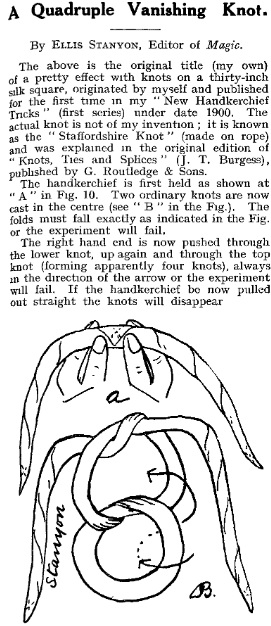Help us get to over 8,749 articles in 2024.
If you know of a magician not listed in MagicPedia, start a New Biography for them. Contact us at magicpediahelp@gmail.com
Difference between revisions of "Chefalo Knot"
(Created page with "'''Chefalo Knot''', is a vanishing knot credited and named after Chefalo. The knot was shown to him when he was a boy by a sailor. He used it as an impromptu item in hi...") |
|||
| (4 intermediate revisions by 3 users not shown) | |||
| Line 1: | Line 1: | ||
| − | '''Chefalo Knot''', is a vanishing knot credited and named after [[Chefalo]]. | + | '''Chefalo Knot''', is a vanishing knot credited and named after [[Chefalo]]. [[File:QuadrupleVanishingKnot.jpg|thumb|''Magic World'', (7), 107]] |
| − | The knot was shown to him when he was a boy by a sailor. He used it as an impromptu item in his non-professional repertoire. | + | The knot was shown to him when he was a boy by a sailor. He used it as an impromptu item in his non-professional repertoire. |
| + | Quadruple Vanishing Knot was first published by Stanyon in his "New Handkerchief Tricks" (first series) under date 1900. And again under by [[Ellis Stanyon]] in [[Magic World]] in 1913.<ref>Stanyon, E. (1913). A Quadruple Vanishing Knot. ''Magic World'', (7), 107.</ref> | ||
| + | Stanyon suggested that the original edition of [https://archive.org/details/cu31924014519940 Knots, Ties and Splices] by J.T. Burgess stated that the actual knot was known as the "Staffordshire Knot". However, this knot does not appear in this book. | ||
| + | The first known publication of what is now known as the Chefalo knot was in 1723 in [https://archive.org/details/b30531688_0003 Récréations Mathématiques et Physiques] by French mathematician Jacques Ozanam (1640-1718), a new edition by [[Grandin]] who added a new chapter entitled "Tours de gibecière". The history of this dissolving knot is likely much older. | ||
| + | |||
| + | Chefelo performed the trick for Stanyon when compiling " Exclusive Magical Secrets" (1912) in all innocence of the fact of its previous publication. Hence Chefalo's innocent association with the then new and exclusive secret. In a personal interview with Chefalo, he informed Stanyon that he does not claim the knot trick as it was shown to him when quite a boy by an old sailor. | ||
{{References}} | {{References}} | ||
| Line 10: | Line 15: | ||
[[Category:Illusions]] | [[Category:Illusions]] | ||
| − | |||
Latest revision as of 17:12, 23 January 2024
Chefalo Knot, is a vanishing knot credited and named after Chefalo.The knot was shown to him when he was a boy by a sailor. He used it as an impromptu item in his non-professional repertoire.
Quadruple Vanishing Knot was first published by Stanyon in his "New Handkerchief Tricks" (first series) under date 1900. And again under by Ellis Stanyon in Magic World in 1913.[1]
Stanyon suggested that the original edition of Knots, Ties and Splices by J.T. Burgess stated that the actual knot was known as the "Staffordshire Knot". However, this knot does not appear in this book.
The first known publication of what is now known as the Chefalo knot was in 1723 in Récréations Mathématiques et Physiques by French mathematician Jacques Ozanam (1640-1718), a new edition by Grandin who added a new chapter entitled "Tours de gibecière". The history of this dissolving knot is likely much older.
Chefelo performed the trick for Stanyon when compiling " Exclusive Magical Secrets" (1912) in all innocence of the fact of its previous publication. Hence Chefalo's innocent association with the then new and exclusive secret. In a personal interview with Chefalo, he informed Stanyon that he does not claim the knot trick as it was shown to him when quite a boy by an old sailor.
References
- ↑ Stanyon, E. (1913). A Quadruple Vanishing Knot. Magic World, (7), 107.
